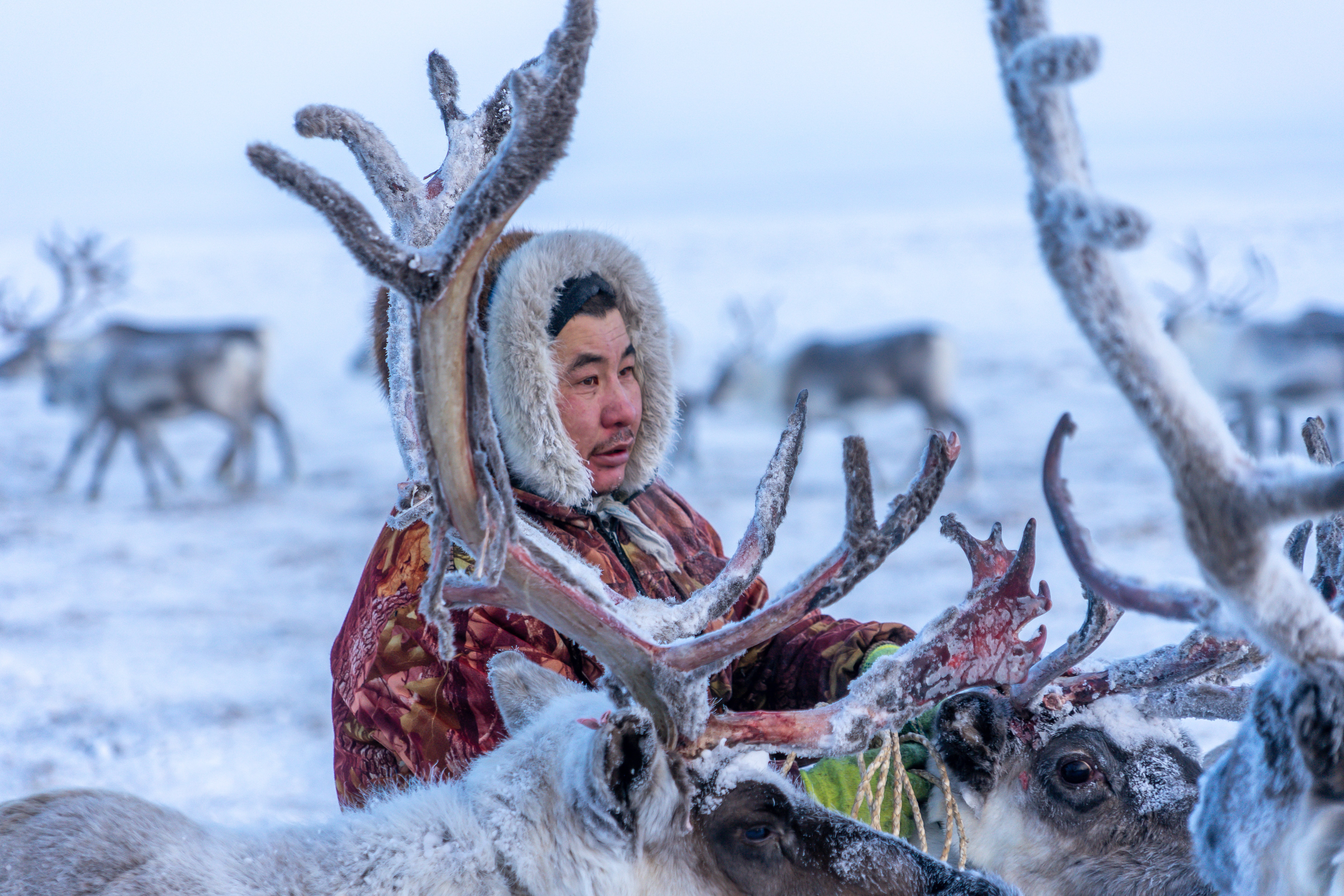Tagluk
“Tagluk” is the name given to the ethnic Mäyt, nomadic reindeer herders who live in small clans across the arctic north of Nas Iscan territory. Tagluk conduct a biannual migration between summer and winter grazing territories, many of which run between Amnari territories to the south and east, and Adayakt to the north and west.
Known History
The Tagluk are one of the oldest ethnic groups known to exist, having been found mentioned in records dating from the late Five Empires period. They is no evidence of interactions with the southern empires, but some Basati authors make mention of strangers who travelled over the mountains with large herds of reindeer, living in permafrost regions and trading meat and other reindeer products for basic goods and services along the northwestern Basati border. Because Tagluk do not keep extensive written records, and have no access to slate or hub technology, their history is largely passed down in the form of long epic poems which are sung in groups during migrations. Their home territories are so remote that they were not even contacted during the early Foundation Period by Amnari establishing the city state of Nas Isca. First Amnari contact was only made in the early 2400s, as the Gaps stabilised to a point where it became possible to expend resources on issues other than defence. Early contact with the Tagluk was highly limited, owing to the remoteness and difficulty of traversing the terrain. Tagluk are almost permanently on the move, with small encampments at either end of their migration routes for reindeer breeding and birthing cycles of the year. As a tight-knit community based around an extended family group, they are often insular and only trade with outsiders when absolutely necessary. Their customs and traditions are believed to have remained largely unchanged for thousands of years.Nomadic Cycle
Tagluk are constantly on the move, herding large groups of reindeer between breeding and birthing grounds. They themselves ride on small dog-sleds, capable of carrying one or two people, or one person and a small [em]Tag[/em], or hut, which serves as a home for the family on the move. These are very small, usually with only one or two bunks and a small galley inside, so families generally sleep apart while on migration. Tagluk are, by tradition, experts in both reindeer management and the care and breeding of sled-dogs, which they also trade with surrounding groups for any goods or services they require.Amnari Contact
Beshi Almady Clinic
For more, see Rooks and Kings Clinical Provision Team In the late 4590s, the Senior Master Watcher Andiru Produced a white paper suggesting that there were enough resources within the Amnari Alliance to provide medical and other services to those living outside the Seven Bubbles. He himself had a particular interest in exploring the northern borders of Nas Iscan territory, his own home state. He had already been on several early visits and met with Tagluk clans during their southerly migration. By the early 4600s, he had won approval for the establishment of a small clinic close to the Beshi Almady camp, at a location the Tagluk referred to as Reinkäyl. This town was generally used for trading with other groups, including the Amnari, who the Tagluk regarded as outsiders. Andiru set up a clinical provision team, initially establishing a medical clinic providing care out of Taga, due to the lack of suitable building space.Current Status
The Tagluk remain an independent ethnic group. However, they have in recent years been infiltrated by several Adayakt factions. The Tagluk nominally trade with the Adayakt for resources and additional food, especially in the most northern and western sections of their migratory route. This has been supplemented by frequent attempts by Adayakt Houses to buy out sections of land considered part of the Tagluk’s migratory path (these are known as luka).Naming Traditions
Family names
Tagluk take a second name after their given name from the location of their summer camp. For example, all Tagluk taking the name Almady were born at the Beshi Almady camp (close to the settlement of Reinkäyl). The tradition amongst the Tagluk is that giving this name will enable all members of that camp to find their way home if they become lost during the long migration to or from the summer grazing plains.
Culture
Major language groups and dialects
Tagluk and dialectic variants are spoken by the majority of the clans, although there are some distinctive patterns with a variety of loan-words drawn from surrounding non-nomadic communities with whom the Tagluk frequently trade.
Common Dress code
Tagluk wear clothes made entirely from reindeer parts. They have a tradition of using all parts of the animal in some way, which may be borne out of the harsh environment in which they live.
Art & Architecture
Tagluk have a tradition of snow-art, where they spread grain in patterns for reindeer to follow. This creates images which can only be seen from the air.
Coming of Age Rites
It is traditional for each member of a young Tagluk’s family to make items of clothing for them at their coming of age, which is around fifteen years of age, although is actually marked by the number of migrations the child has completed growing up, and so varies by two or three years, depending on fluctuations in the migration cycle.
Funerary and Memorial customs
Tagluk are not normally buried, owing to living on permanently frozen ground. Dead Tagluk are generally placed in specially designated charnel grounds, which are considered to be sacred. These are lands populated by various carrion birds and scavenging animals. The Tagluk view this as returning the borrowed energy of the earth back to where it belongs once the human soul has left it.




Comments